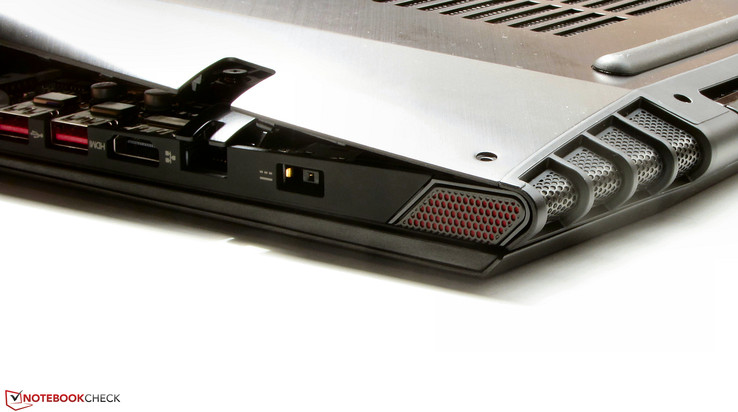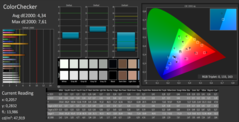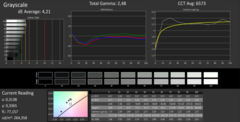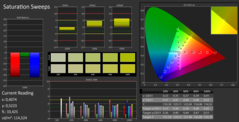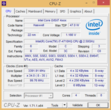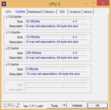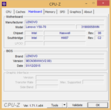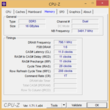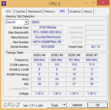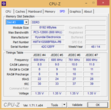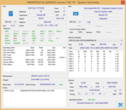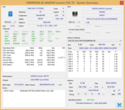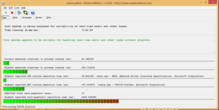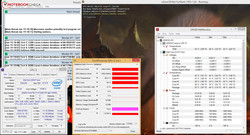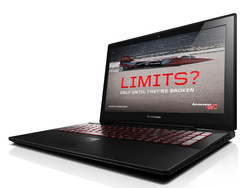Lenovo Y50-70 (GTX 960M, 4K) Notebook Review

For the original German review, see here.
Lenovo offers relatively compact gaming laptops in a 15.6-inch size within its Y50-70 lineup. We previously tested various models from this range, and are now facing a new model that is equipped with a graphics core from Nvidia's GeForce 900M lineup. To be precise, it is the GeForce GTX 960M. Our report reveals whether the new GPU has any advantages.
There are plenty of rivals for the Y50-70. Examples would be Acer's Aspire VN7-591G, HP's Omen, Asus' G501JW, MSI's GE62, and Schenker's A505.
Since we have tested several models of the Y50-70, we will not go in-depth about casing, connectivity, input devices, screen or speakers. The corresponding information can be found in the reviews of the Lenovo Y50-70 and Lenovo Y50-70 (59424712).
Case
Since the Y50 does not have a maintenance cover, the casing has to be opened for maintaining/upgrading the hardware. Lenovo has complicated this matter unnecessarily. After all screws have been released from the bottom, the base unit's tray comes off at three sides by itself. There are no clips. Solely the rear is not released. The fans' covers are part of the bottom tray. Since the tray could not be removed without effort, we did not make any further attempts in order to prevent damaging the casing.
Display
We have previously tested a 4K model of the Y50-70. It features the same Samsung screen as in our present review sample. The rates differ slightly, which is normal. Two identically built screens will never correspond to one hundred percent. The installed Samsung screen can only serve with an average brightness and average contrast.
A review about the Full HD model of our present review sample will be published within the next few days. Basically, the 4K and the Full HD screen are identical. The latter has a higher contrast and lower brightness than the 4K screen.
| |||||||||||||||||||||||||
Brightness Distribution: 85 %
Center on Battery: 264 cd/m²
Contrast: 600:1 (Black: 0.44 cd/m²)
ΔE ColorChecker Calman: 4.34 | ∀{0.5-29.43 Ø4.79}
ΔE Greyscale Calman: 4.21 | ∀{0.09-98 Ø5}
77% sRGB (Argyll 1.6.3 3D)
49% AdobeRGB 1998 (Argyll 1.6.3 3D)
53.2% AdobeRGB 1998 (Argyll 3D)
77.6% sRGB (Argyll 3D)
51.5% Display P3 (Argyll 3D)
Gamma: 2.48
CCT: 6573 K
| Lenovo IdeaPad Y50-70-59441231 IPS, 3840x2160 | Lenovo IdeaPad Y50-70-59441229 IPS, 1920x1080 | Acer Aspire VN7-591G-727P IPS, 3840x2160 | Schenker XMG A505 IPS, 1920x1080 | MSI GE62-2QFUi716H11 IPS, 3840x2160 | HP Omen IPS, 1920x1080 | Asus G501JW-CN168H IPS, 1920x1080 | |
|---|---|---|---|---|---|---|---|
| Display | -23% | 13% | 24% | 1% | 22% | 41% | |
| Display P3 Coverage (%) | 51.5 | 39.51 -23% | 64.9 26% | 66.1 28% | 52.2 1% | 64.4 25% | 76.5 49% |
| sRGB Coverage (%) | 77.6 | 59.4 -23% | 66.9 -14% | 92.1 19% | 78.7 1% | 92.6 19% | 100 29% |
| AdobeRGB 1998 Coverage (%) | 53.2 | 40.82 -23% | 66.9 26% | 67 26% | 54 2% | 65.5 23% | 76.4 44% |
| Screen | 1% | 16% | 34% | 3% | 10% | 21% | |
| Brightness middle (cd/m²) | 264 | 214 -19% | 322 22% | 284 8% | 268 2% | 315 19% | 344 30% |
| Brightness (cd/m²) | 253 | 227 -10% | 325 28% | 275 9% | 227 -10% | 301 19% | 337 33% |
| Brightness Distribution (%) | 85 | 79 -7% | 90 6% | 87 2% | 74 -13% | 85 0% | 95 12% |
| Black Level * (cd/m²) | 0.44 | 0.23 48% | 0.37 16% | 0.23 48% | 0.39 11% | 0.38 14% | 0.31 30% |
| Contrast (:1) | 600 | 930 55% | 870 45% | 1235 106% | 687 15% | 829 38% | 1110 85% |
| Colorchecker dE 2000 * | 4.34 | 4.9 -13% | 3.77 13% | 2.46 43% | 4.12 5% | 4.37 -1% | 5.98 -38% |
| Greyscale dE 2000 * | 4.21 | 4.13 2% | 5.36 -27% | 2.3 45% | 3.65 13% | 5.46 -30% | 5.75 -37% |
| Gamma | 2.48 89% | 2.44 90% | 2.39 92% | 2.32 95% | 2.5 88% | 2.48 89% | 2.51 88% |
| CCT | 6573 99% | 7239 90% | 7163 91% | 6393 102% | 6423 101% | 7915 82% | 7366 88% |
| Color Space (Percent of AdobeRGB 1998) (%) | 49 | 38 -22% | 61 24% | 60 22% | 49 0% | 60 22% | 71 45% |
| Color Space (Percent of sRGB) (%) | 77 | 59 -23% | 92 19% | 100 30% | |||
| Total Average (Program / Settings) | -11% /
-5% | 15% /
15% | 29% /
31% | 2% /
2% | 16% /
13% | 31% /
26% |
* ... smaller is better
Performance
Lenovo's 15.6-inch Y50-70 gaming laptop has more than enough computing power for every day, and renders all up-to-date games smoothly. Our review sample is available for approximately 1500 Euros. Lenovo also has many other configurations. The currently lowest priced model from the lineup is sold for just below 800 Euros.
Processor
As in the previously tested models of Lenovo's Y50, Intel's Core i7 4710HQ (Haswell) quad-core processor is also inside our present review sample. It is a standard mobile processor with a TDP of 47 watts. It has more than enough computing power for all common application scenarios. The installed quad-core processor only provides a slight advantage over dual-core processors in single-thread performance, which is more important for routine use. It can first clearly distance itself in applications optimized for multiple cores.
The CPU operates at a base speed of 2.5 GHz, which can be boosted to 3.3 GHz (four cores), 3.4 GHz (two cores), and 3.5 GHz (one core) via Turbo. The CPU processes single-thread applications at full speed in AC mode. However, the laptop only exhibits the same behavior as its sister models in multi-thread applications, which are only processed at the base speed (2.5 GHz). Thus, the CPU clearly remains behind its potential in multi-thread applications. Laptops from the competition, such as Acer's Aspire VN7-591G, do not have this problem. The Y50 shows a slightly different behavior in battery mode. The processor begins processing at 800 MHz, and gradually increases that up to 2.8 GHz only to suddenly drop to 800 MHz again. That is then repeated from the beginning.
| Sunspider - 1.0 Total Score (sort by value) | |
| Lenovo IdeaPad Y50-70-59441231 | |
| Lenovo IdeaPad Y50-70-59441229 | |
| Acer Aspire VN7-591G-727P | |
| Acer Aspire V15 Nitro VN7-591G-75TD | |
| MSI GE62-2QFUi716H11 | |
| HP Omen | |
| Mozilla Kraken 1.1 - Total (sort by value) | |
| Lenovo IdeaPad Y50-70-59441231 | |
| Acer Aspire VN7-591G-727P | |
| Acer Aspire V15 Nitro VN7-591G-75TD | |
| MSI GE62-2QFUi716H11 | |
| HP Omen | |
| Octane V2 - Total Score (sort by value) | |
| Lenovo IdeaPad Y50-70-59441231 | |
| Acer Aspire VN7-591G-727P | |
| Acer Aspire V15 Nitro VN7-591G-75TD | |
| MSI GE62-2QFUi716H11 | |
| HP Omen | |
| Peacekeeper - --- (sort by value) | |
| Lenovo IdeaPad Y50-70-59441231 | |
| Acer Aspire VN7-591G-727P | |
| Acer Aspire V15 Nitro VN7-591G-75TD | |
| MSI GE62-2QFUi716H11 | |
* ... smaller is better
System Performance
The system runs smoothly, and we did not encounter any problems. The PCMark benchmark scores are good. However, the Y50 clearly lags behind comparable contenders, such as the Aspire VN7-591G, which also features a 4K screen. It becomes evident here that the processor in Lenovo's laptop does not utilize its Turbo in the multi-thread tests. Both the Aspire and the Y50 generally score worse than its sister models that have a Full HD screen. When the desktop resolution of the 4K models is reduced to Full HD, the PCMark scores climb to a comparable level. The system performance of our review sample cannot be increased; Lenovo has utilized all possibilities.
| PCMark 7 Score | 4921 points | |
| PCMark 8 Home Score Accelerated v2 | 2554 points | |
| PCMark 8 Creative Score Accelerated v2 | 3465 points | |
| PCMark 8 Work Score Accelerated v2 | 3746 points | |
Help | ||
| PCMark 8 - Home Score Accelerated v2 (sort by value) | |
| Lenovo IdeaPad Y50-70-59441231 | |
| MSI GE60-2PEi781B | |
| Acer Aspire VN7-591G-727P | |
| Schenker XMG A505 | |
| Gigabyte P34W V3 | |
| MSI GE62-2QFUi716H11 | |
| HP Omen | |
Storage Device
The Y50 sports a solid state drive from Samsung. It is a 2.5-inch model with a capacity of 512 GB. The laptop's owner can use approximately 410 GB of that. The remaining storage capacity is divided among the Windows installation, recovery partition and a partition for the Y50's drivers and applications. The SSD can serve with overall good transfer rates.
Graphics Card
The installed GeForce GTX 960M graphics core is an entry-level model from the GPU upper range. It clocks at a base rate of 1097 MHz, which can be increased to 1176 MHz via Turbo. The GPU's maximum speed is only a few percent higher than that of the former GeForce GTX 860M graphics core. Since the cores only differ in speed, the 960 core only scores marginally better than its precursor in the 3DMark benchmark. However, the difference between the 960 and 860 models in the Y50 is greater than among the comparable models of Acer's Aspire VN7-591G lineup. The reason: The GeForce GTX 860M GPUs in the Y50 models do not clock at their maximum possible speeds.
In addition to the GeForce core, Intel's HD Graphics 4600 GPU has also found its way into the laptop. Both cores form a graphics switching solution (Optimus). Intel's GPU is intended for routine and battery mode. The GeForce GPU is enabled in performance-driven applications, such as computer games. Switching is automatic, but the user can always intervene manually.
| 3DMark 11 Performance | 5486 points | |
| 3DMark Ice Storm Standard Score | 42649 points | |
| 3DMark Cloud Gate Standard Score | 13326 points | |
| 3DMark Fire Strike Score | 3907 points | |
Help | ||
Gaming Performance
Lenovo's Y50 is explicitly aimed at gamers. Thus, it is not surprising that it can render all current games smoothly. It is normally possible to select the Full HD resolution and high to very high quality settings. The resolution and/or quality level has to be reduced in some games, for example "The Witcher 3". The frame rates are only slightly higher than that of laptops equipped with a GeForce GTX 860M graphics core. However, the advantage over 860 models of the Y50 is greater, like in the 3DMark benchmarks, because the GeForce GTX 860M GPUs in the Y50 models do not clock at their maximum possible speeds.
The screen's maximum resolution (3840 x 2160 pixels) can only be fully utilized in rare cases. This option is at most possible in games that only have moderate hardware requirements. The Y50 only achieves just below 70 fps in the benchmark of the game "Dirt Rally" in very low quality settings. The rates drop to 25.3 fps in medium and 22.8 fps in high settings.
| low | med. | high | ultra | 4K | |
|---|---|---|---|---|---|
| Tomb Raider (2013) | 257.8 | 178 | 112.6 | 52.1 | |
| Dragon Age: Inquisition (2014) | 99 | 90.4 | 56.1 | 38.2 | |
| Battlefield Hardline (2015) | 142.2 | 131.6 | 53.7 | 33.7 | |
| Dirt Rally (2015) | 233.7 | 108.6 | 70.8 | 32.7 | 22.8 |
| The Witcher 3 (2015) | 81.1 | 55 | 26.3 | 13.7 | 9.3 |
Emissions
System Noise
It sometimes happens that the fans in the Y50 are inactive, and then not a noise is heard. However, the fans usually spin at a low speed. It should not be surprising that they speed up under load; after all, the laptop features high-performance hardware. We measured a noise level of 49.2 dB during the stress test, which is an acceptable rate in this performance category.
Noise level
| Idle |
| 29.6 / 31.1 / 34.3 dB(A) |
| Load |
| 45 / 49.2 dB(A) |
 | ||
30 dB silent 40 dB(A) audible 50 dB(A) loud |
||
min: | ||
| Lenovo IdeaPad Y50-70-59441231 4710HQ/GTX 960M | Acer Aspire VN7-591G-727P 4720HQ/GTX 960M | Schenker XMG A505 4720HQ/GTX 960M | MSI GE62-2QFUi716H11 4720HQ/GTX 970 | HP Omen 4710HQ/GTX 860M | Asus G501JW-CN168H 4720HQ/GTX 960M | |
|---|---|---|---|---|---|---|
| Noise | 3% | -1% | -3% | -5% | -0% | |
| Idle Minimum * (dB) | 29.6 | 30 -1% | 29.2 1% | 29.4 1% | 32.2 -9% | 31 -5% |
| Idle Average * (dB) | 31.1 | 32.2 -4% | 30.8 1% | 31.8 -2% | 34.3 -10% | 33.8 -9% |
| Idle Maximum * (dB) | 34.3 | 35 -2% | 42.6 -24% | 36 -5% | 36.2 -6% | 34.1 1% |
| Load Average * (dB) | 45 | 41.7 7% | 41.6 8% | 46 -2% | 46.2 -3% | 44.3 2% |
| Load Maximum * (dB) | 49.2 | 42.6 13% | 43.8 11% | 51.8 -5% | 46.6 5% | 44.4 10% |
* ... smaller is better
Temperature
The Y50 performed the stress test (Prime95 and Furmark run for at least one hour) differently in AC and battery mode. The processor clocked at 2.5 GHz and the graphics core at 1085 MHz in AC mode. They were throttled to 1.4 to 1.5 GHz (CPU) and 836 (GPU) in battery mode. The laptop's temperatures are acceptable in view of the hardware configuration. Several measuring points on the casing surpassed fifty degrees Celsius.
(-) The maximum temperature on the upper side is 58.8 °C / 138 F, compared to the average of 40.5 °C / 105 F, ranging from 21.2 to 68.8 °C for the class Gaming.
(-) The bottom heats up to a maximum of 51.9 °C / 125 F, compared to the average of 43.3 °C / 110 F
(+) In idle usage, the average temperature for the upper side is 29.9 °C / 86 F, compared to the device average of 33.9 °C / 93 F.
(+) The palmrests and touchpad are cooler than skin temperature with a maximum of 30.3 °C / 86.5 F and are therefore cool to the touch.
(±) The average temperature of the palmrest area of similar devices was 28.9 °C / 84 F (-1.4 °C / -2.5 F).
| Lenovo IdeaPad Y50-70-59441231 4710HQ/GTX 960M | Acer Aspire VN7-591G-727P 4720HQ/GTX 960M | Schenker XMG A505 4720HQ/GTX 960M | MSI GE62-2QFUi716H11 4720HQ/GTX 970 | HP Omen 4710HQ/GTX 860M | Asus G501JW-CN168H 4720HQ/GTX 960M | |
|---|---|---|---|---|---|---|
| Heat | -13% | -16% | -0% | 3% | 19% | |
| Maximum Upper Side * (°C) | 58.8 | 53 10% | 56.4 4% | 53.4 9% | 45.7 22% | 43.1 27% |
| Maximum Bottom * (°C) | 51.9 | 53.2 -3% | 61.8 -19% | 43.3 17% | 53.5 -3% | 47.4 9% |
| Idle Upper Side * (°C) | 33.1 | 38.6 -17% | 41.3 -25% | 34.7 -5% | 34.2 -3% | 26.2 21% |
| Idle Bottom * (°C) | 32.5 | 45.9 -41% | 40.2 -24% | 39.6 -22% | 34.6 -6% | 27.1 17% |
* ... smaller is better
Energy Management
Power Consumption
The energy requirement reached up to 15.9 watts in idle mode - a very low rate for a high-performance gaming laptop. We normally measure rates of over 20 watts from the contenders. Lenovo appears to have the energy requirement well under control. The power consumption climbed up to 115.5 watts in the stress test. That is apparently too much for the 135 watt power supply because the battery was drained during the stress test. This problem did not occur in gaming routine; the laptop consumed approximately 100 watts in this scenario.
| Off / Standby | |
| Idle | |
| Load |
|
Key:
min: | |
| Lenovo IdeaPad Y50-70-59441231 4710HQ/GTX 960M | Acer Aspire VN7-591G-727P 4720HQ/GTX 960M | Schenker XMG A505 4720HQ/GTX 960M | MSI GE62-2QFUi716H11 4720HQ/GTX 970 | HP Omen 4710HQ/GTX 860M | Asus G501JW-CN168H 4720HQ/GTX 960M | |
|---|---|---|---|---|---|---|
| Power Consumption | -27% | -24% | -31% | -23% | -58% | |
| Idle Minimum * (Watt) | 10.9 | 16.2 -49% | 11.2 -3% | 14.7 -35% | 15 -38% | 13.6 -25% |
| Idle Average * (Watt) | 14.9 | 20.2 -36% | 18.6 -25% | 20.9 -40% | 19 -28% | 38.1 -156% |
| Idle Maximum * (Watt) | 15.9 | 22.8 -43% | 26 -64% | 25.6 -61% | 23.7 -49% | 40.7 -156% |
| Load Average * (Watt) | 101 | 96.4 5% | 100.2 1% | 101 -0% | 87.9 13% | 81.6 19% |
| Load Maximum * (Watt) | 115.5 | 126.9 -10% | 147.6 -28% | 138.8 -20% | 129.5 -12% | 81.6 29% |
* ... smaller is better
Battery Runtime
The Y50 managed an idle runtime of 6:28 hours. It thus clearly outperforms its rival Acer Aspire VN7-591G (3:36 h). Idle mode is ascertained using Battery Eater's Reader's test. The screen is set to minimum brightness, the energy-savings profile is enabled, and the wireless modules are off. The Y50 shut down after 1:24 hours of load. The Aspire (0:58 h) is depleted sooner. The load runtime is checked with Battery Eater's Classic test. The screen runs in maximum brightness, the high-performance profile and radio modules are enabled.
Lenovo's laptop stopped our real-life Wi-Fi test after 3:23 hours. Again, the Aspire (2:46 h) lags behind. This test simulates the load induced when websites are opened. The "Balanced" profile is enabled, and the screen's brightness is set to approximately 150 cd/m². We test the video playback time by running the short movie Big Buck Bunny (H.264 encoding, 1920 x 1080 pixels) in a loop. The wireless modules are disabled, and the screen's brightness is set to approximately 150 cd/m². The Y50 lasted 3:27 hours. The Aspire (2:56 h) shut down earlier.
Lenovo is quite able to convert the relatively low idle energy requirement in decent battery runtimes for a gaming laptop. The contender Acer is outperformed here. The battery capacity of both laptops ais almost identical (Lenovo: 55 Wh, Acer: 52 Wh).
| Lenovo IdeaPad Y50-70-59441231 55 Wh | Acer Aspire VN7-591G-727P 52 Wh | Schenker XMG A505 62 Wh | MSI GE62-2QFUi716H11 51 Wh | HP Omen 58 Wh | Asus G501JW-CN168H 60 Wh | |
|---|---|---|---|---|---|---|
| Battery runtime | -27% | 7% | -26% | -24% | -6% | |
| Reader / Idle (h) | 6.5 | 3.6 -45% | 5.9 -9% | 3.9 -40% | 4.3 -34% | |
| H.264 (h) | 3.5 | 2.9 -17% | 3.5 0% | 2.8 -20% | ||
| WiFi v1.3 (h) | 3.4 | 2.8 -18% | 2.7 -21% | 3.2 -6% | ||
| Load (h) | 1.4 | 1 -29% | 1.8 29% | 1.1 -21% | 1.2 -14% | |
| WiFi (h) | 3.6 | 3.5 |
Pros
Cons
Verdict
Lenovo's Y50-70 59441231 is a 15.6-inch gaming laptop. The installed processor has more than enough computing power for all common application scenarios. The GeForce GTX 960M graphics core renders all current games smoothly. It also produces slightly higher frame rates than the GeForce GTX 860M precursor. It should not be surprising that the laptop reaches relatively high temperatures and produces noise in view of the hardware configuration. The installed 4K screen made a mixed impression. On the one hand, it is a viewing angle stable IPS screen, and on the other, its brightness and contrast could be better. It is rarely possible to use it in in games, and primarily boosts the purchase price. Like its direct contender Acer Aspire VN7-591G, the lack of a maintenance cover has to be criticized. The casing of both laptops has to be opened for replacing or installing a hard drive.
All things considered, the present device can be filed under "model upgrade". The only real innovation is the GeForce GTX 960M graphics core. Owners of a laptop with the former GPU do not really have a reason for switching to a GTX 960M graphics core. The performance gain is marginal.
Lenovo IdeaPad Y50-70-59441231
- 06/20/2015 v4 (old)
Sascha Mölck












